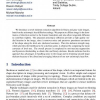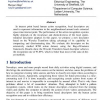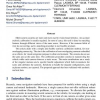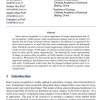BMVC
2010
14 years 5 months ago
2010
This paper shows how semantic attribute features can be used to improve object classification performance. The semantic attributes used fall into five groups: scene (e.g. `road�...
135
click to vote
BMVC
2010
14 years 5 months ago
2010
We introduce a novel skeleton extraction algorithm in binary and gray-scale images, based on the anisotropic heat diffusion analogy. We propose to diffuse image in the dominance o...
BMVC
2010
14 years 5 months ago
2010
In this paper, we propose a method for simultaneous human full-body pose tracking and activity recognition from time-of-flight (ToF) camera images. Simple and sparse depth cues ar...
BMVC
2010
14 years 5 months ago
2010
In interest point based human action recognition, local descriptors are used to represent information in the neighbourhood around each extracted space-time interest point. The per...
BMVC
2010
14 years 5 months ago
2010
In this paper we propose a novel approach to introducing semantic relations into the bag-of-words framework. We use the latent semantic models, such as LSA and pLSA, in order to d...
BMVC
2010
14 years 5 months ago
2010
Recognizing 3D objects from arbitrary view points is one of the most fundamental problems in computer vision. A major challenge lies in the transition between the 3D geometry of o...
BMVC
2010
14 years 5 months ago
2010
Many practical applications require an accurate knowledge of the extrinsic calibration (i.e., pose) of a moving camera. The existing SLAM and structure-from-motion solutions are n...
BMVC
2010
14 years 5 months ago
2010
Multi-camera systems are more and more used in vision-based robotics. An accurate extrinsic calibration is usually required. In most of cases, this task is done by matching featur...
BMVC
2010
14 years 5 months ago
2010
Local coordinate coding has recently been introduced to learning visual feature dictionary and achieved top level performance for object recognition. However, the computational co...
BMVC
2010
14 years 5 months ago
2010
Insect species recognition is a typical application of image categorization and object recognition. Unlike generic image categorization datasets (such as the Caltech 101 dataset) ...




